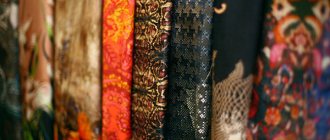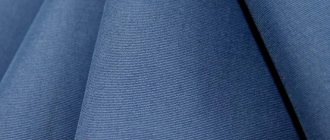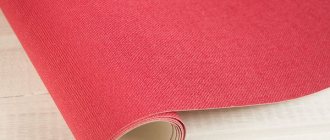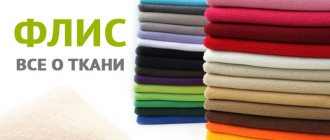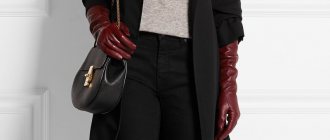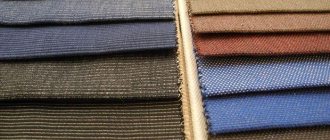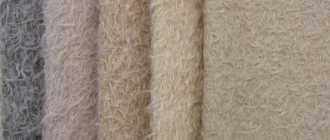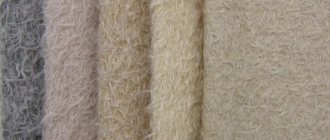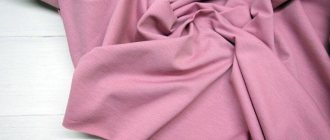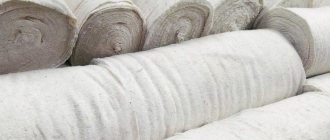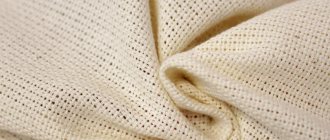DescriptionOrigin
Lycra is a soft, highly stretchable material of synthetic origin. It has average breathability and is noticeably electrified. This fabric is almost never used as the only material in the production of a particular product. Typically, elastic material is combined with fibers that have almost no stretch: the addition of lycra makes any fabric more elastic and soft. Moreover, the higher the percentage of this matter in relation to other components, the more the fabric will stretch.
This fabric is made artificially from polymer. Lycra fibers can be produced in several ways: wet, dry or reaction molding. The resulting fibers are thoroughly washed with hot water and sent to a heat chamber for 20-30 hours. The temperature in this chamber reaches 120 °C. Then the threads are connected with a special loop or plain weave, due to which elasticity and tendency to stretch are achieved.
Products containing this material are usually very convenient and comfortable to use. Lycra fits the body well, but does not restrict movement or cause discomfort.
This fabric was first produced in the USA in 1959. Lycra gained popularity when durable and elastic stockings and tights began to be made from it.
How Lycra was invented
This universal material was developed by American chemical scientists in 1958. 5 years later (in 1963), Japanese scientists became interested in lycra and began its large-scale production. A couple of years later, the fabric gained popularity in Europe, and in 1970 it appeared in Russia.
Initially, American scientists set themselves the goal of creating lycra material, ideal for making belts and corsets. The fashion for such corrective products gradually faded away, and the fabric itself did not provide the required density. To prevent the idea from being a failure, in the 60s lycra became the basis for elastic (nylon) stockings. Later, the range of its use in light industry only expanded.
Helpful information:
What kind of fabric is poplin?
What kind of fabric is percale?
History and manufacturing methods
Lycra was developed by DuPont and is a highly elastic, synthetic fiber belonging to the class of fabrics with polyurethane threads (polyester). Their production began in 1958 in the USA, in 1963 in Japan, and already in 1965 it was widespread in European countries.
- The wet method consists of rinsing the fibers at a temperature of 90-95 degrees and winding them onto a bobbin, then the fibers are placed in thermal chambers with a temperature of 120 for two or three days.
- The dry method is the most common and economical production method: oiled fibers are wound onto spools and placed in heat chambers at 80 degrees for 3 hours.
- Reaction spinning involves making fibers by adding macrodisocyanate to a bath of polyurethane solution, resulting in a chemical reaction to form Lycra fibers.
- Polymer melt extrusion —fibers are produced by exposing a polymer alloy to ethylene glycol.
Initially, the development of this type of fiber was intended for the manufacture of corsets, however, given the high elasticity of the fabric and the insufficient density of the material, lycra corsets were not widely used on the market, but stockings, tights and socks made of lycra are in great demand among consumers, and manufacturers are actively expanding the scope application of this material.
Lycra is often used in a small percentage of other types of fabric , but even a small number of threads gives the fabric elasticity and strength. It goes well with natural fabrics and artificial fibers due to such a feature as good stretchability - it can increase 6-8 times, which makes it indispensable in the production of tight-fitting textiles. However, it should be noted that products consisting of 100% lycra are practically not found on the market.
Production of lycra threads
When asked what Lycra is, the first thing that comes to mind is a synthetic material. It is made in four ways.
Brief description of each:
- Chemical . During chemical reactions, liquid polyurethane interacts with macrodisocyanate, resulting in the formation of new fibers - lycra.
- Wet . Polyurethane fibers are first boiled, then tightly wound onto a special reel and dried for 72 hours in a heat chamber at a temperature of 120 degrees.
- Dry . Unlike the previous method, polyurethane fibers are not wetted with boiling water before winding onto bobbins, but are carefully treated with special oil.
- Polymer extrusion . A viscous polyurethane solution is squeezed out through special holes, resulting in the formation of synthetic fibers.
Any of the stated methods produces fibers with the same technical characteristics . Only the time and financial costs for producing the material change.
Application
Lycra fabric is very popular; it is used in almost all areas of the clothing and textile industry. Since it began to be actively used by weaving factories, the list of applications has grown significantly. Today, fabrics with this fiber are used to sew the following goods:
- tight tops, dresses, sundresses, skirts;
- denim products - trousers, dresses, shirts;
- home and sleeping clothes, pajamas;
- tracksuits, especially for fitness and gymnastics;
- underwear, including openwork;
- swimsuits, swimming trunks and swimming suits;
- shapewear, corsets, various belts for figure correction;
- children's costumes, overalls, bodysuits, sandboxes;
- tights and socks of various types, leggings, gaiters;
- outerwear of different models;
- various medical accessories - bandages, medical corsets.
Things made from such material are very popular for one simple reason - it is practical, not subject to premature wear, does not stretch, and is easy to wash. With proper care, such wardrobe items last a long time.
Material properties
Elastane is rarely used as an independent fabric; it is more often found in combination with other threads to improve the technical performance of the latter. Its popularity is growing, which is explained by the following properties of the material:
- Marking . Polyurethane fibers do not get dirty. Dirt does not get clogged into the structure of the fabric, but remains only on the surface. If you shake the product, not a trace will remain.
- Comfort . The fabric is thin, light and pleasant to the touch, endowed with “breathable” properties.
- Elasticity . Polyurethane threads stretch 8 times, and the fabric to which they are added does not lose its presentation when frequently stretched.
- Durability . Lycra increases the shelf life of fabric with its addition by almost 2 times.
- Density _ This indicator varies between 1.1-1.3 g/cm³, which provides a “stretch” effect.
- Resistance to external influences. Lycra does not fade in the sun, retains its integrity in salt water, etc.
- Practicality . The fabric does not wrinkle, does not deform after repeated washing, lasts a long time, and does not require special care for the product.
- Good drape . The material produces soft, beautiful and uniform assemblies.
Where is Lycra used?
Adding lycra to fabric expands its functional properties and makes it universal. The following materials are used to sew:
- Shorts, swimsuits, knee socks, tight dresses and men's shirts.
- Sports suits and clothing for shaping.
- Underwear of different styles - from stretch and slimming to lace.
- Socks, stockings and tights.
- All models in the superslim category, for example, jeans.
- Bandages and fixatives for medical purposes.
Products made with lycra cause virtually no trouble for their owners if they are properly cared for.
Combination with other fabrics
Lycra in the composition of various materials is more often found as an additive, rarely used as a monofilament. The advantages include eliminating shortcomings and improving the quality of the latter. Having determined the difference, the buyer will always look at the label and study the composition of the material of the item of clothing he likes.
Lycra with cotton fabrics
The fabric, which combines cotton with lycra, retains its shape for a long time, stretches well, wrinkles less and has excellent air permeability. According to its properties, the material is breathable, pleasant to the body, and has a long service life.
Footer also goes well with lycra. The material itself is light, weightless, and breathable. The combination of footer with lycra makes it denser and helps maintain the shape of the product after repeated washing and natural drying.
Lycra with jersey
Knitwear is more often used for sewing children's and sportswear. The material is light, pleasant to the body, stretches and breathes. In combination with lycra, knitwear becomes more elastic and dense, and is less deformed. When 5% elastane is added to the ribana, it effectively fits the figure and stretches to the required size.
Lycra with synthetics
Viscose is a lightweight, breathable material, soft and pleasant to the touch. To increase its strength and elasticity, polyurethane threads are added to the composition, but not more than 5% of the total amount of synthetic fibers. If this indicator is exceeded, the fabric becomes rigid and the breathability is impaired.
Lycra, ribana, cotton, viscose: application features
As mentioned above, lycra is used extremely rarely in its pure form; the most common combinations are lycra-ribana, lycra-viscose, lycra-cotton. In each of the above combinations, Lycra brings additional qualities to the fabric.
Ribana (pictured) is a cross-knit jersey, its main characteristics are softness and practicality. Ribana is used mainly for making children's and sports items.
As a rule, the percentage of lycra in rib fabrics does not exceed 5 and such fabrics are considered completely natural. For fabrics such as ribana, Lycra fibers provide elasticity, wear resistance and improve the overall characteristics of the knitwear.
Cotton , on the contrary, having a lot of advantages (hypoallergenic, breathable, hygienic, stain-resistant), is difficult to iron, inelastic and wrinkles very much. But with the addition of lycra fibers, it acquires additional properties: elasticity, high breathability, products are easy to iron, and do not deform when washed.
Viscose can be called the most natural and pleasant of synthetic fibers, and its characteristics are very similar to cotton. Lycra adds elasticity, silky shine and a flowing effect to viscose.
Care instructions
To ensure that Lycra clothing can be worn longer without loss of color and original appearance, follow these recommendations for caring for the products:
- wash in a machine or by hand at 40 degrees;
- use delicate detergents;
- dry naturally (without dryers);
- Iron from the wrong side, use the “delicate” and “silk” modes.
It’s easy, the main thing is to make it a rule. You will see that an item with the addition of lycra will last and not deteriorate for a single year.
Lycra in fabrics
A material consisting of 100% lycra is considered extremely rare. Typically, such threads are woven together with other types of natural, synthetic, and artificial fibers. To change the nature of the fabric and give it a greater degree of elasticity, it is enough that the composition of lycra is only 2% of the total volume.
Depending on the purpose of the material, the percentage of elastane is determined. To obtain a fabric that will stretch well and at the same time perfectly retain its original shape, the percentage of lycra content can be quite high.
Lycra is excellent for optimizing the performance of cotton, viscose, rib and lining fabrics. Some properties of these fabrics directly depend on the presence of elastic threads in them.
When you see a mark on the trade label about the percentage of materials, including lycra, you don’t have to think about purchasing such a product. Products made from fabrics combined in this way will last a long time without losing shape or color.
Customer Reviews
“For a long time I couldn’t understand what kind of fabric Lycra was. They add it everywhere, but don’t use it on their own. The truth came in comparison. I had synthetic without lycra, I didn’t wear it for so long. I constantly had to wash, the smell of sweat appeared instantly. That’s when I realized the difference between kid sweaters. Not only do they allow air to pass through, but they also accentuate the figure.” Irina, 35 years old.
“I have a lot of things with elastane, I’ve been wearing them for several years now, and they don’t wear them out. Lycra gets dirty less often, and after washing it looks like new. The main thing is to take proper care. I wash it by hand in cool water, don’t wring it too hard, and dry it outside the balcony. As a fabric, Lycra has many advantages, and the price is also reasonable.” Olga, 42 years old.
“And I was always wondering how lycra differs from elastane. It turned out to be nothing. The differences are in the names of the same material. Lycra is added everywhere, and rightly so. With proper care, you have a chance to wear lycra items longer.” Arina, 45 years old.
What is fullicra
When you look at the tag on the clothing, the question arises what kind of fabric it is, full lycra. This is the name given to fabrics with a high elastane content. The materials contain no more than 5% elastic fibers. In full lycra the proportion of elastane is 8% or higher. Moreover, this is how not only artificial, but also natural fabrics, such as a cooler or footer, are created.
The difference between full lycra is that such a canvas stretches in all directions.
History of the invention of Lycra
As stated earlier, Lycra was invented within the . Research work on the creation of this fiber began in 1946 and cost the company $10 million. The goal of developing superelastic fiber was to introduce it into the production of corsetry and belts, but when Lycra was born in 1959, women abandoned such a piece of clothing. Therefore, the creators were forced to look for another use for the material and soon found it: stocking manufacturers appreciated all the advantages of the amazing fiber.
And already in 1963, lycra appeared in Japan, by 1965 - in European countries, by 1970 - in Russia. Today this fiber is known and popular all over the world.
What is Lycra
Lycra is the most popular brand of polyurethane fiber, which is the brainchild of the American chemical industry, or rather, part of it. Essentially, this is the same spandex, as they say in Canada and the USA, and elastane in the Russian tradition.
If we talk about the structure of this material, lycra is a segmented polyurethane, which belongs to artificial elastane fibers. They consist of flexible segments connected to each other by unique “bridges” - rigid connections. They protect the fiber from ruptures of soft segments, due to which the material becomes elastic.
Lycra is produced in laboratory conditions by wet, dry and reaction molding or extrusion from a polymer melt.
Discussion Questions: What are the differences between the different fibers?
What is the difference between Lycra and elastane?
Comparing two fibers is incorrect and is equivalent to comparing the term “Car” and the brand of a popular car. Lycra is elastane with certain properties and characteristics.
How does spandex differ from other man-made fibers?
As mentioned above, Spandex is elastane, that is, the entire group of polyurethane synthetic threads. They contain polyurethane rubber. Artificial threads contain viscose, obtained from cellulose and chemical impurities. Such threads are easier and more cost-effective to produce than spandex. However, they can shrink significantly after washing.
